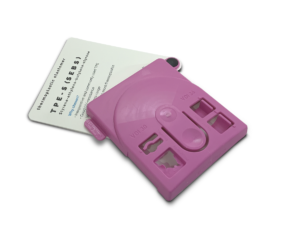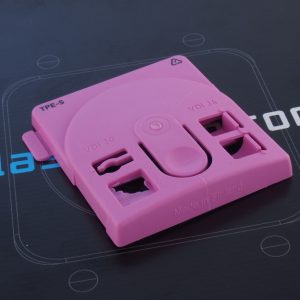
TPE-S is one of the varieties of TPE (thermoplastic elastomer). Other common TPE types include TPE-U, TPE-O and TPE-V; TPE-E and TPE-A are somewhat less common. The TPE types differ by behaviour and properties, but the Plasticprop sample demonstrates their basic nature. TPE-S is a thermoplastic elastomer used very commonly, especially in 2K injection moulding. It is often referred to as SEBS, or styrene-ethylene/butylene-styrene. The styrene of the chain end segments is responsible for the thermal plasticity and the middle section for the elasticity. SEBS itself cannot be shaped, but if it is mixed with PP, for example, the resulting material can be injection-moulded.
Why choose it?
- Inexpensive but efficient material with good surface appearance. I usually start my search from TPE-S.
- It’s easy to find reference cases that show how the material has performed under similar conditions. Not being able to find good references is a good indication of the material’s suitability for the intended use.
- Wide hardness range including very soft grades.
- Good adhesion with most other thermoplastics in 2K applications.
- Transparent grades are available.
- Good UV-resistance when stabilized.
Why not choose it?
- Limited chemical resistance. TPE-V is often chosen over TPE-S in applications that are in contact with oil. Some of the new cross-linked products are said to have improved chemical resistance.
- Compared to other TPEs, thermal resistance is poor.
Typical applications:
- Soft handles (2K) in electric tools and devices, pliers, screwdrivers and garden tools.
- Shoe soles (despite fairly poor abrasion resistance)
The cheaper SBS is also a TPE-S grade plastic. The difference is explained here.
By examining the Plasticprop sample made of TPE-S, you can draw for example the following conclusions:
- Even though the sample is straight and reasonably neat, the impression of quality is not very high. In most cases, the material is used in 2K solutions in combination with some harder substance. This improves the impression of quality.
- There are spots and splashes on the surface, a problem that often plagues 2K runs.
- The glossy mould surface is not replicated in the product; this does not fully depend on hardness. The TPE-S and TPE grades are generally dull-surfaced. In the mould, the product adheres strongly to polished surfaces, so it should be avoided.
- TPE-S is very fluid, and the process injection rates are high. The filling window is incomplete, probably because the surroundings had already set before the pressure in the area increased with mould cavity filling. The substance has flown through the hinge without any problem.
